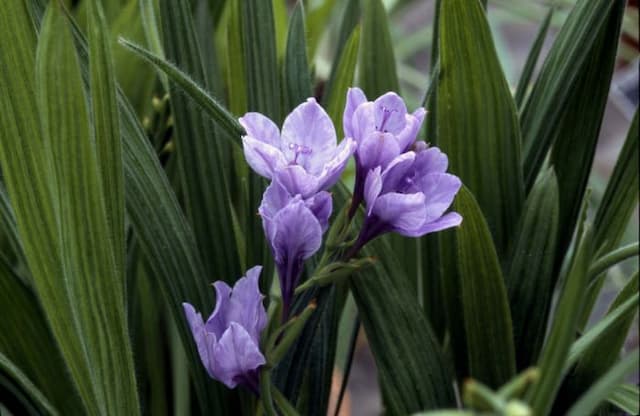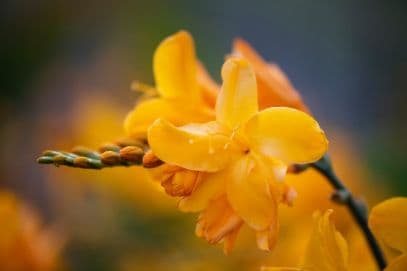Dutch Iris Iris 'Langport Wren' (IB)

ABOUT
Iris 'Langport Wren' is a striking perennial with an eye-catching combination of colors and patterns, which makes it a favorite among garden enthusiasts. The plant displays beautiful blooms that typically bear three upright petals known as standards and three downward-curving petals called falls. The standards of Iris 'Langport Wren' showcase a warm, rich violet hue which contrasts elegantly against the falls. The falls themselves are a deeper violet, often veering towards a blue-purple shade, and are adorned with a splash of yellow or gold at the base. This bright burst of color is known as the beard, which is a fuzzy, caterpillar-like texture that adds a unique touch to the blossom. The leaves of the Iris 'Langport Wren' are sword-shaped, presenting a crisp, streamlined look. They are a rich, deep green, providing the perfect backdrop to the vibrant colors of the flowers. Each flower is ornately detailed, with delicate veining on the petals that can be seen upon closer inspection. The overall impression of the Iris 'Langport Wren' is one of elegance and sophistication, with its rich colors, detailed petal patterns, and gracefully arching foliage, making it a must-have for any garden that seeks to make a statement through floral beauty.
About this plant
 Names
NamesFamily
Iridaceae
Synonyms
Langport Wren Iris
Common names
Iris 'Langport Wren' (IB).
 Toxicity
ToxicityTo humans
The Iris 'Langport Wren' is considered to be mildly toxic if ingested. The most common common name for this plant is simply "iris". The rhizomes and bulbs are the plant parts that commonly contain the highest concentration of toxic compounds, primarily irisin, iridin, or irisine. If a person ingests part of an iris, they may experience symptoms such as stomach pain, nausea, vomiting, and diarrhea. In severe cases, there could be a risk of more serious effects such as heart issues or breathing difficulties, but such extreme reactions are rare. Generally, symptoms are mild to moderate and self-limiting, but medical advice should be sought if ingestion occurs.
To pets
The Iris 'Langport Wren', commonly known as "iris", is toxic to pets if ingested. The rhizomes and bulbs are especially poisonous due to the presence of compounds like irisin, iridin, or irisine. When a pet consumes parts of an iris, it may exhibit symptoms including gastrointestinal upset, manifested as drooling, vomiting, and diarrhea. In severe cases, there might be more serious systemic effects such as lethargy or even liver damage, especially in animals that consume large quantities. Pet owners should be cautious and keep irises out of reach of their pets. If a pet has ingested iris, it is important to contact a veterinarian promptly.
 Characteristics
CharacteristicsLife cycle
Perennials
Foliage type
Deciduous
Color of leaves
Green
Flower color
Mixed
Height
2 feet 24 inches (60 cm)
Spread
2 feet 24 inches (60 cm)
Plant type
Bulb
Hardiness zones
4
Native area
Europe
Benefits
 General Benefits
General Benefits- Attractive Flowers: Iris 'Langport Wren' produces beautiful blooms that add color and aesthetic appeal to gardens.
- Easy Maintenance: This plant is known for being easy to care for, requiring minimal upkeep once established.
- Drought Tolerance: Once established, it can tolerate periods of drought, making it suitable for water-wise gardens.
- Pest Resistant: It is generally resistant to pests and diseases, reducing the need for chemical treatments.
- Attracts Pollinators: The flowers attract bees and other pollinating insects, supporting local ecosystems.
- Versatility in Landscaping: Can be used in a variety of garden styles, including borders, water gardens, and cottage gardens.
- Seasonal Interest: Offers seasonal interest with its foliage and structure even when not in bloom.
- Soil Adaptability: Adapts to a range of soil types, although it prefers well-drained soils.
- Cold Hardy: Can survive in colder climates, making it suitable for a variety of growing zones.
 Medical Properties
Medical PropertiesThis plant is not used for medical purposes.
 Air-purifying Qualities
Air-purifying QualitiesThis plant is not specifically known for air purifying qualities.
 Other Uses
Other Uses- Ink Production: The rhizomes of the Iris can be used to create a natural ink, which has historically been used for writing and drawing.
- Eco-Friendly Dyes: Parts of the Iris, particularly the flowers, can be used to make natural dyes for textiles, offering a sustainable alternative to synthetic dyes.
- Fragrance Extraction: Some species of Iris are used in the production of perfumes and essential oils, with a scent that is commonly described as woody or floral.
- Artistic Inspiration: The unique beauty of the Iris 'Langport Wren' has inspired many artists and photographers, making it a subject of visual arts.
- Gastronomy: Although not commonly used, the petals of some Iris species are edible and can add a colorful touch to salads and desserts.
- Environmental Education: The Iris can be used as an educational tool to teach about plant biology, species diversity, and conservation efforts.
- Garden Design: Irises, with their striking appearance, are often used in water garden designs, providing both aesthetic beauty and habitat for wildlife.
- Fish Pond Maintenance: The Iris 'Langport Wren' can be planted around fish ponds where they can help provide shade and shelter for fish and other aquatic life.
- Soil Erosion Control: The root system of Irises can help prevent soil erosion, making it useful for planting on slopes and banks.
- Craft Materials: Dried Iris flowers and stems can be used in floral arrangements and for various crafting projects, such as wreath making.
Interesting Facts
 Feng Shui
Feng ShuiThe Iris is not used in Feng Shui practice.
 Zodiac Sign Compitability
Zodiac Sign CompitabilityThe Iris is not used in astrology practice.
 Plant Symbolism
Plant Symbolism- Faith - Irises often symbolize faith and hope, reflecting the plant's ability to survive and thrive in a variety of conditions.
- Wisdom - Due to its regal appearance, the iris is associated with wisdom and valued for its beauty and elegance.
- Courage - The iris can represent courage and admiration, likely inspired by its bold colors and striking shape.
- Purity - White and light-colored irises in particular symbolize purity and innocence.
- Royalty - Irises are symbolic of royalty and nobility, as seen in their association with the French monarchy and the fleur-de-lis.
 Water
WaterIntermediate Bearded Iris, like 'Langport Wren', should be watered deeply once a week during the active growing season, provided there is no significant rainfall. During dry spells or unusually hot weather, increase watering to twice a week. The goal is to provide about an inch of water each time, which could roughly translate to about 0.5 gallons for a smaller planting area. Ensure the soil is well-draining to prevent water from accumulating around the roots, which can lead to rot. During the dormant season, in fall and winter, reduce watering significantly since the plant’s water requirements diminish.
 Light
LightIntermediate Bearded Iris such as 'Langport Wren' thrives in full sun to partial shade. They should get at least six hours of direct sunlight each day, preferably morning sun with some afternoon shade in extremely hot climates. The ideal spot for these irises is an area that is bright and sunny with some protection from the intense late afternoon sun to keep their colors vibrant and promote healthy growth.
 Temperature
TemperatureIntermediate Bearded Iris 'Langport Wren' can tolerate a range of temperatures but grow best when daytime temperatures are between 68°F and 86°F. The plant can survive minimum temperatures down to around 14°F and maximum temperatures up to about 100°F. However, consistently ideal temperatures are those that are mild to warm, which encourage robust growth and flower development.
 Pruning
PruningPruning Intermediate Bearded Iris, like 'Langport Wren', is done primarily to remove spent flower stalks and promote healthy foliage. After blooming, cut flower stems close to the base to prevent seeding and to tidy the plant. In late summer or fall, trim away any brown or damaged leaves. A thorough cleanup is recommended post first frost to remove any dead foliage and reduce the chance of pests and diseases overwintering.
 Cleaning
CleaningAs needed
 Soil
SoilThe ideal soil mix for the Intermediate Bearded Iris, commonly called the Iris 'Langport Wren', should be well-draining and slightly acidic to neutral in pH, ranging from 6.5 to 7.0. A combination of loamy garden soil mixed with sand and compost is suitable. Ensure the soil is fertile and has good aeration to prevent waterlogging, which can cause root rot.
 Repotting
RepottingIntermediate Bearded Iris like 'Langport Wren' generally do not need frequent repotting and can thrive in the same spot for several years. However, they should be divided and repotted every 3 to 5 years to rejuvenate growth and prevent overcrowding, which can lead to diminished blooming.
 Humidity & Misting
Humidity & MistingIntermediate Bearded Iris, including 'Langport Wren', are relatively tolerant of varying humidity levels but prefer drier conditions. They thrive best in areas with low to average humidity and should be planted in a location with good air circulation to minimize the risk of fungal diseases.
 Suitable locations
Suitable locationsIndoor
Place in well-lit spot, ensure good airflow, avoid overwatering.
Outdoor
Full sun, well-drained soil, space 12-24 inches apart.
Hardiness zone
3-9 USDA
 Life cycle
Life cycleThe Iris 'Langport Wren' (Langport Wren Iris), an Intermediate Bearded Iris, begins its life cycle as a dormant rhizome. Upon planting in late summer to early fall, it establishes roots and foliage before entering winter dormancy. In spring, new growth emerges and the plant enters its rapid vegetative stage, producing long, sword-shaped leaves. Flowering occurs in late spring to early summer, displaying distinctive purple-brown blooms that attract pollinators and may set seeds. Once blooming finishes, the plant continues to grow and store energy in its rhizome throughout the summer. As temperatures drop in late fall, the Langport Wren Iris returns to dormancy, concluding its annual cycle until the following spring.
 Propogation
PropogationPropogation time
Spring-Early Summer
Iris 'Langport Wren', a variety of bearded iris, is typically propagated through division of its rhizomes. The best time to divide and propagate these irises is late summer to early fall, after the blooming period has ended and at least 6 weeks before the first hard freeze to give the plants time to become established. To propagate by division, gently lift the clump of iris out of the ground using a spade or fork. Shake off the excess soil and examine the rhizome for signs of rot or disease, discarding any unhealthy portions. Healthy specimens should be firm with a good set of roots and one or more leaf fans. Using a sharp knife sterilized with a 10% bleach solution (1 part bleach to 9 parts water) or rubbing alcohol, cut the rhizome into sections, ensuring each division has at least one fan of leaves and a portion of healthy roots. Replant these divisions about 12 to 24 inches apart and 1 inch deep (2.54 cm) into well-draining soil, positioning them so the leaves are facing upwards and the roots are spread out. Water them in well to help settle the soil and remove air pockets.









